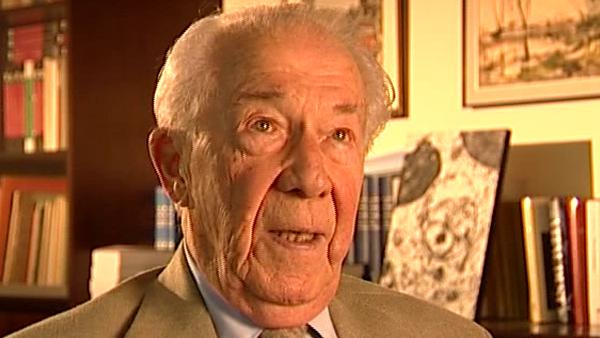NEXT STORY

The sixth enzyme: Uricase
RELATED STORIES

NEXT STORY

The sixth enzyme: Uricase
RELATED STORIES


|
Views | Duration | |
|---|---|---|---|
| 31. Using centrifugal fractionation to locate enzymes | 162 | 03:29 | |
| 32. The first fractionation experiment | 166 | 03:52 | |
| 33. Surprising results of the first fractionation experiment | 170 | 04:14 | |
| 34. Experiments resulting from the 2nd International Biochemistry... | 143 | 02:21 | |
| 35. Experimenting with phenolphthalein | 118 | 03:08 | |
| 36. George Hogeboom and Walter Schneider | 144 | 04:08 | |
| 37. Using Jesuit logic to solve a problem | 323 | 01:39 | |
| 38. Three possible explanations for our findings | 133 | 02:30 | |
| 39. Acid phosphatase: A new kind of particle | 133 | 06:01 | |
| 40. Experimenting with acid phosphatase | 117 | 04:41 |


Well... so we had arrived at a conclusion that acid phosphatase belonged to a different kind of particle – an unknown... a new kind of particle – and we had established a new five-fraction scheme whereby at least analytically... not preparatively, but analytically, such a localisation could be ascertained. And so we decided, well, let's go and look at all the enzymes that have been reported in the literature as coming down partly with the mitochondria and partly with the microsomes. And there were about 50 enzymes... had already been studied, largely by Hogeboom and Schneider whom I mentioned, and so we went and spotted about a dozen enzymes that seemed to be worthy of... of study. By that time I had been joined by... well, no, I mentioned Berton Pressman before. Berton Pressman helped us a great deal in measuring cytochrome oxidase, actually. Because here again you had to purify cytochrome C first from horse heart before you could measure the oxidase. Then a number of other enzymes were studied, involving so-called DPN and TPN, diphospho puridene nucleotide and triphospho puridene nucleotide, which are now known as ADP adenoside... no not ADP... NAD, nicotinamide adenine dinucleotide, and NADP, nicotinamide adenine dinucleotide phosphate, and so we studied enzymes that would reduce these compounds which are important coenzymes and, again, here we had to get some mutton liver, sheep liver, and extract those coenzymes before, so it's an awful smell. So extract those coenzymes from boiled liver tissue and so on, but eventually we ended up with having measured about 12 enzymes; of those 12 about half turned out to be uninteresting, from our point of view – mostly they seemed to be truly partly associated with mitochondria and partly with microsomes, so no single location there. But five enzymes... or six enzymes turned out to show a significant peak in this intermediary fraction. I've already... and they included, of course, acid phosphatase, on which we'd done our first work. They included beta glucuronidase, which my friend Gianetto had worked on; they included a cathepsin protease which Berton Pressman also had worked on; and they included two nucleases, ribonuclease and deoxyribonuclease. Both being enzymes acting on DNA and RNA but with an acid pH optimum, contrary to some of the other enzymes of that kind that are known. And so, in addition to the centrifugation experiments, we also did latency experiments and all those five enzymes turned out to behave in the same way. When we injured the membrane of the particles, if we got, let's say, 60% of the acid phosphatase out we would get between 55 and 65% of the other four enzymes out at the same time, so they centrifuged together, they came out together, they showed the same latency properties, so, presumably, they were all associated with the same kind of particle.
Belgian biochemist Christian de Duve (1917-2013) was best known for his work on understanding and categorising subcellular organelles. He won the Nobel Prize in Physiology or Medicine in 1974 for his joint discovery of lysosomes, the subcellular organelles that digest macromolecules and deal with ingested bacteria.
Title: Experimenting with acid phosphatase
Listeners: Peter Newmark
Peter Newmark has recently retired as Editorial Director of BioMed Central Ltd, the Open Access journal publisher. He obtained a D. Phil. from Oxford University and was originally a research biochemist at St Bartholomew's Hospital Medical School in London, but left research to become Biology Editor and then Deputy Editor of the journal Nature. He then became Managing Director of Current Biology Ltd, where he started a series of Current Opinion journals, and was founding Editor of the journal Current Biology. Subsequently he was Editorial Director for Elsevier Science London, before joining BioMed Central Ltd.
Tags: Robert Gianetto, Walter Schneider, George Hogeboom, Berton Pressman
Duration: 4 minutes, 41 seconds
Date story recorded: September 2005
Date story went live: 24 January 2008